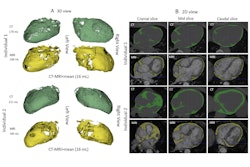MRI has revealed that shape changes in the buttocks may be an indicator of type 2 diabetes, and that these changes differ between women and men, according to research to be presented at RSNA 2025.
The finding is from a study that used 61,290 MRI exams housed in the UK Biobank database to create detailed 3D anatomical models of the gluteus maximus and then explored how variables such as aging, lifestyle, frailty, osteoporosis, and type 2 diabetes were associated with changes in its shape.
“Unlike past studies that mainly looked at muscle size or fat, we used 3D shape mapping to pinpoint exactly where the muscle changes, giving a much more detailed picture,” said lead author Marjola Thanaj, PhD, a senior research fellow at the University of Westminster’s Research Centre for Optimal Health in London, in an RSNA release.
The MRI approach used in this study -- 3D statistical shape analysis -- characterizes tissue morphology and localizes shape variation via statistical parametric maps, independent of volume. While widely used for internal organs, its application to skeletal muscle, especially the gluteus maximus, remains limited, Thanaj and colleagues noted.
In the study, the technique revealed that the gluteus maximus shape exhibited “outward deformation” associated with body mass index, alcohol intake, physical activity, and grip strength, and an “inward deformation” associated with age, frailty, osteoporosis, and sedentary time (p < 0.05).
 A flow chart of the study.RSNA
A flow chart of the study.RSNA
“People with higher fitness, as measured by vigorous physical activity and hand grip strength, had a greater gluteus maximus shape, while aging, frailty, and long sitting times were linked to muscle thinning,” Thanaj said.
Moreover, in participants with type 2 diabetes, men showed muscle shrinkage, while women showed enlarged muscle that was likely due to infiltration of fat within the muscle, the researchers found.
The results suggest that men and women have very different biological responses to the same disease, according to Thanaj.
She noted that shape changes in the gluteus maximus may indicate early functional decline and metabolic compromise in people with type 2 diabetes, reflecting sex-specific differences in response to insulin tolerance that require further study.
Thanaj will discuss the research in the afternoon on Monday, December 1, in the Learning Center during an imaging informatics poster session.




















